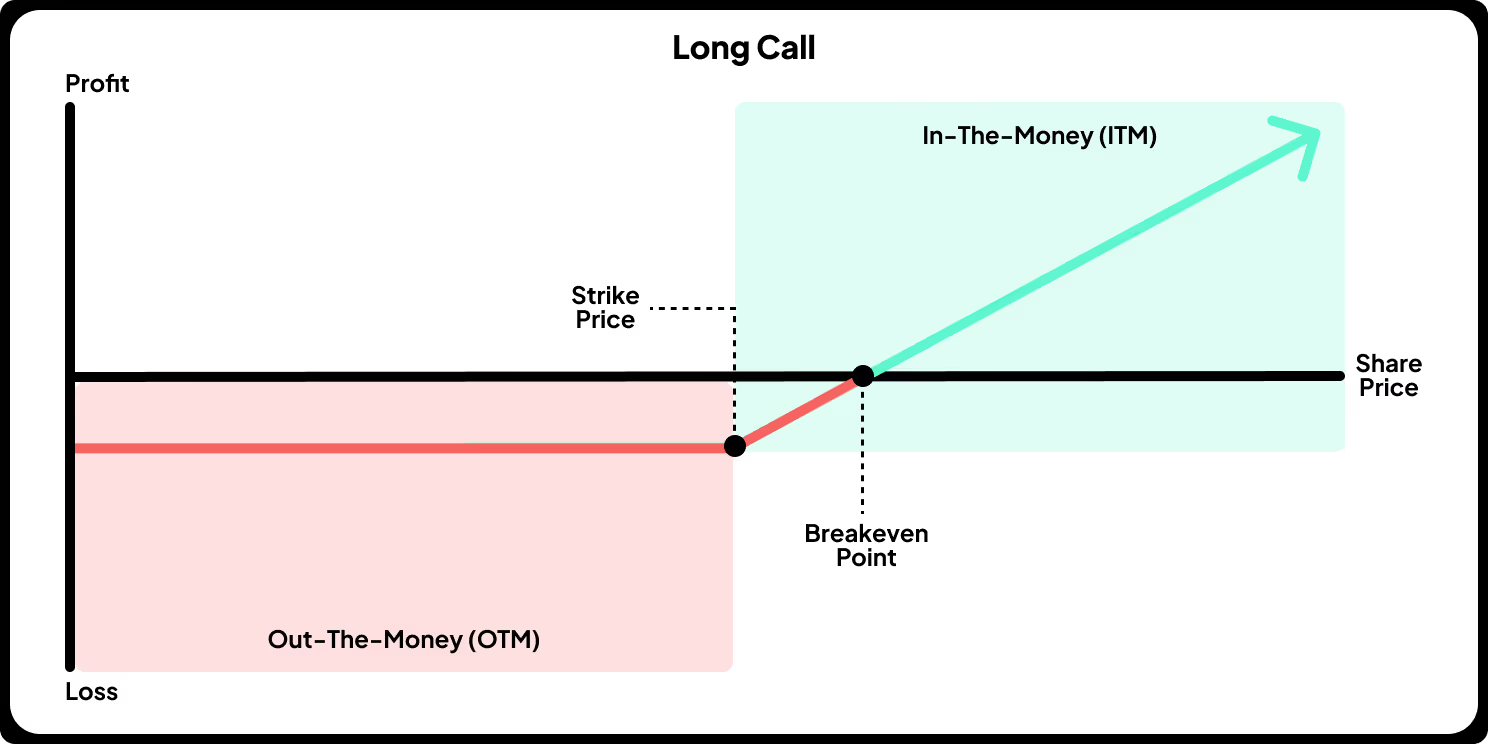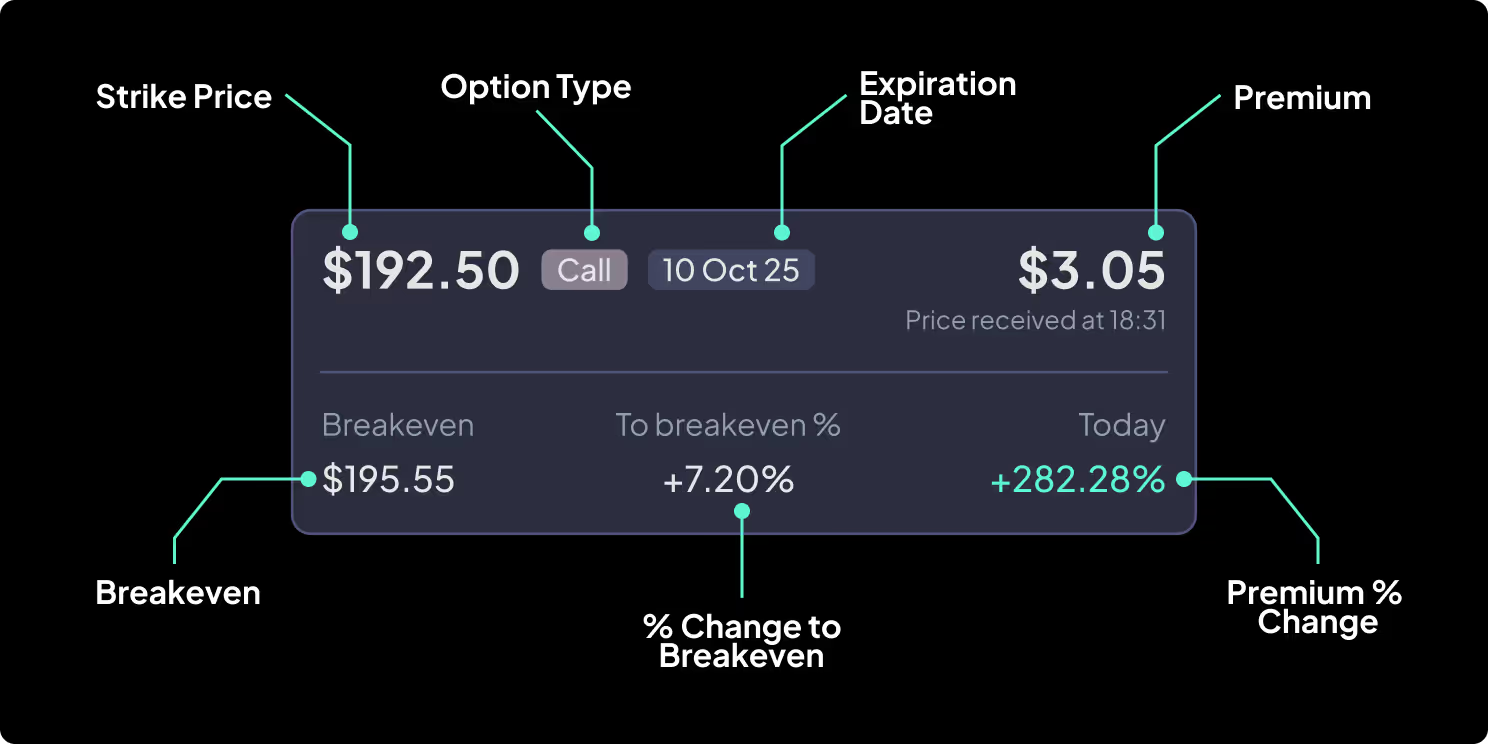What is a Call Option?
A call option is a contract that gives the buyer the right, but not the obligation, to purchase a specific asset (such as a stock) at a predetermined price (the strike price) before a specific expiration date.
Think of it as a reservation to buy a stock at a fixed price, regardless of how high the market price might go.
However, the option may expire worthless if the price doesn’t move in your favour.
Key Components of a Call Option
- Underlying Asset: The stock or security the option is based on
- Strike Price: The price at which you can buy the underlying asset
- Premium: The cost you pay to purchase the option
- Expiration Date: The date when the option expires
- Contract Size: Typically represents 100 shares of the underlying stock
- Intrinsic Value: The price of the Underlying Asset minus the Strike Price, if the option is inthe money.
How Call Options Work: A Real-World Example
Let's use a practical example to understand how call options work in a real-world scenario.
Important: These examples are for illustrative purposes only. Options are complex products and not suitable for all investors. Capital is at Risk.
Example 1: Tesla (TSLA) Call Option
Imagine Tesla is currently trading at $250 per share. You believe Tesla's price will increase in the coming weeks, perhaps due to an upcoming earnings announcement or product launch.
Instead of purchasing Tesla shares outright, you decide to buy a call option with:
- Strike price: $260
- Expiration: 30 days from now
- Premium: $10 per share
Rationale for this strategy:
- Limited Capital Requirement: To buy 100 shares of Tesla, you'd need $25,000 ($250 per share × 100 shares ).With the call option, you only pay $1,000 ($10 per share × 100) for the right to purchase those shares at $260.
- Defined Risk: Your maximum loss is limited to the premium paid ($1,000), which you will lose if the option expires worthless, regardless of how far Tesla's price might fall. In the case of owning the stock, you could lose more than $1,000 if Tesla’s price falls.
- Leveraged Upside: While your percentage returns could be much higher than if you had simply bought the shares outright, this also comes with a higher risk of losing your entire investment in the option.
- Why the CallOption Gains Value: All else equal, as Tesla’s stock price moves closer to or above the $260 strike price, the chance to buy Tesla for $260 becomes more valuable. Let’s say Tesla’s price hit $265, the chance to buy it for $260 starts to look potentially more attractive - which makes other investors willing to pay more for it, increasing its value.
Scenario Analysis
Let's explore different potential outcomes:
Scenario 1:Tesla rises to $300 by expiration
Your call option gives you the right to buy 100 shares at $260, while the market price is $300.
- Intrinsic value: $40 per share ($300 market price - $260 strike price)
- Profit calculation: ($40 × 100) - $1,000 = $3,000
- Return on investment: 300% ($3,000 profit on $1,000 investment)
Had you bought the shares directly, your profit would have been $5,000 ($50 × 100), but your return on investment would have been just 20% ($5,000 profit on $25,000 investment).
Scenario 2:Tesla rises slightly to $265 by expiration
Your call option allows you to buy at $260, with the market at $265.
- Intrinsic value: $5 per share ($265 market price - $260 strike price)
- Profit calculation: ($5 × 100) - $1,000 = -$500
- Result: Despite the stock rising, you lose $500 because the increase wasn't enough to offset your premium.
Had you bought the shares directly, your profit would have been $1,500 ($15 × 100), and your return on investment would have been 6% ($1,500 profit on $25,000 investment).
Scenario 3:Tesla falls to $220 by expiration
Your call option is "out of the money" since the market price ($220) is below your strike price ($260).
- Intrinsic value: $0
- Result: You lose your entire premium ($1,000)
Had you bought the shares directly, your loss would have been $3,000 (-$30 × 100), and your return on investment would have been -12% ($3,000 loss on $25,000 investment).
When to Consider Using Call Options
Call options can be potentially useful in several scenario:
- When you're bullish but want limited risk: If you believe a stock will rise but want to cap your potential losses.
- For leverage: When you want exposure to more shares than you could afford to purchase outright.
- Before known events: Ahead of earnings reports, product launches, or other potential price catalysts.

Considerations Before Trading Call Options
- Time Decay: Options lose value as they approach expiration, especially in the final weeks.Why? Because with less time left, there's less chance for the stock to move in a way that makes the option more valuable.
- ImpliedVolatility: Higher volatility generally means more expensive options premiums.
- Break-Even Point: Your break-even is the strike price plus the premium paid. For this option, that would be $260 + $10 = $270 per share.
Recap
Call options can offer a flexible way to participate in a stock's potential upside while limiting your downside risk, but they also carry the risk of losing your entire investment.
They're potentially powerful tools that can be used for speculation, leverage, or hedging, depending on your investment goals and market outlook.
But remember: options trading isn’t for everyone. It's important to thoroughly understand the mechanics and risks before trading options.



